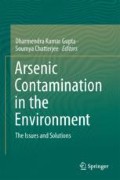Abstract
Plant science research may help to reduce the potential exposure of people to environmental arsenic pollution. In particular, arsenic phytoremediation and development of low arsenic accumulating plants are two main research foci that hold much promise in helping to tackle the arsenic pollution problem. Plant tissue culture has been useful to aid arsenic toxicity and resistance studies in the laboratory which could better inform phytoremediation studies, for example, involving the arsenic hyperaccumulating Pteris vittata (Chinese brake fern). Transfer of arsenic metabolism-related glutaredoxin genes, for example, has been shown to reduce arsenic accumulation in transgenic plants. In vitro plant cell selection may be, however, an attractive alternative to generation of transgenic plants to yield low arsenic accumulating crop plants (somaclonal variants) aiming to lower dietary arsenic intake.
Access this chapter
Tax calculation will be finalised at checkout
Purchases are for personal use only
References
Abedin MJ, Meharg AA (2002) Relative toxicity of arsenite and arsenate on germination and early seedling growth of rice (Oryza sativa L.) Plant Soil 243:57–66
Antonio T, Mantovani M, Fusconi A, Gallo C (2007) In vitro culture of Pteris vittata, an arsenic hyperaccumulating fern, for screening and propagating strains useful for phytoremediation. Caryologia 60:160–164
Ashrafzadeh S, Leung DWM (2015) In vitro breeding of heavy-metal resistant plants: a review. Hortic Environ Biotechnol 56:131–136
Clemens S, Aarts MGM, Thomine S, Verbruggen N (2013) Plant science: the key to preventing slow cadmium poisoning. Trend Plant Sci 18:92–99
Doran PM (2009) Application of plant tissue cultures in phytoremediation research: incentives and limitations. Biotechnol Bioeng 103:60–76
Ibanez S, Talano M, Ontanon O, Suman J, Medina MI, Macek T, Agostini E (2016) Transgenic plants and hairy roots: exploiting the potential of plant species to remediate contaminants. New Biotechnol 33:625–635
Kumar S, Dubey RS, Tripathi RD, Charkrabarty D, Trivedi PK (2015) Omics and biotechnology of arsenic stress and detoxification in plants: current updates and perspective. Environ Int 74:221–230
Li CX, Feng SL, Shao Y, Jiang LN, Lu XY, Hou XL (2007) Effects of arsenic on seed germination and physiological activities of wheat seedlings. J Environ Sci 19:725–732
Liu X, Zhang S, Shan X, Zhu YG (2005) Toxicity of arsenate and arsenite on germination, seedling growth and amylolytic activity of wheat. Chemosphere 61:293–301
Murashige T, Skoog F (1962) A revised medium for rapid growth and bioassays with tobacco tissue cultures. Physiol Plant 15:473–497
Muthukumar B, Joyce BL, Elless MP, Stewart CN (2013) Stable transformation of ferns using spores as targets: Pteris vittata and Ceratopteris thalictroides. Plant Physiol 163:648–658
Nehnevajova E, Herzig R, Erismann KH, Schwitzguebel JP (2007) In vitro breeding of Brassica juncea L. to enhance metal accumulation and extraction properties. Plant Cell Rep 26:429–437
Potters G, Pasternak TP, Guisez Y, Jansen MAK (2009) Different stresses, similar morphogenic responses: integrating a plethora of pathways. Plant Cell Environ 32:158–169
Ren C, Liu XJ, Zhang Z, Wang Y, Duan W, Li SH, Liang ZC (2016) CRISPR/Cas9-mediated efficient targeted mutagenesis in Chardonnay (Vitis vinifera L). Sci Rep 6:32289
Shri M, Kumar S, Chakrabarty D, Trivedi PK, Mallick S, Misra P, Shukla D, Mishra S, Srivastava S, Tripathi RD, Tuli R (2009) Effect of arsenic on growth, oxidative stress, and antioxidant system in rice seedlings. Ecotoxicol Environ Saf 72:1102–1110
Shri M, Dave R, Dwivedi S, Shukla D, Kesari R, Tripathi RD, Trivedi PK, Chakrabarty D (2014) Heterologous expression of Ceratophyllum demersum phytochelatin synthase, CdPCS1, in rice leads to lower arsenic accumulation in grain. Sci Rep 4:5784
Sundaram S, Wu S, Ma LQ, Rathinasabpathi B (2009) Expression of a Pteris vittata glutaredoxin PvGRX5 in transgenic Arabidopsis thaliana increases plant arsenic tolerance and decreases arsenic accumulation in the leaves. Plant Cell Enviorn 32:851–858
Talano MA, Oller WAL, Gonzalez P, Gonzalez SO, Agostini E (2014) Effects of arsenate on tobacco hairy root and seedling growth, and its removal. In Vitro Cell Dev Biol-Plant 50:217–225
Verma PK, Verma S, Pande V, Mallick S, Tripathi RD, Dhankher OP, Chakrabarty D (2016) Overexpression of rice glutaredoxin OsGrx_C7 and OsGrx_C2.1 reduces intracellular arsenic accumulation and increases tolerance in Arabidopsis thaliana. Front. Plant Sci 7:740
Yang X, Chen H, Xu W, He Z, Ma M (2007) Hyperaccumulation of arsenic by callus, sporophytes, and gametophytes of Pteris vittata cultured in vitro. Plant Cell Rep 26:1889–1897
Zhao FJ, McGrath PS, Meharg AA (2010) Arsenic as a food chain contaminant: mechanism of plant uptake and metabolism and mitigation strategies. Annl Rev Plant Biol 61:535–559
Zheng Y, Xu W, He Z, Ma M (2008) Plant regeneration of the arsenic hyperaccumulator Pteris vittata L. from spores and identification of its tolerance and accumulation of arsenic and copper. Acta Physiol Plant 30:249–255
Author information
Authors and Affiliations
Corresponding author
Editor information
Editors and Affiliations
Rights and permissions
Copyright information
© 2017 Springer International Publishing AG
About this chapter
Cite this chapter
Leung, D.W.M. (2017). Potential of Plant Tissue Culture Research Contributing to Combating Arsenic Pollution. In: Gupta, D., Chatterjee, S. (eds) Arsenic Contamination in the Environment. Springer, Cham. https://doi.org/10.1007/978-3-319-54356-7_9
Download citation
DOI: https://doi.org/10.1007/978-3-319-54356-7_9
Published:
Publisher Name: Springer, Cham
Print ISBN: 978-3-319-54354-3
Online ISBN: 978-3-319-54356-7
eBook Packages: Earth and Environmental ScienceEarth and Environmental Science (R0)

